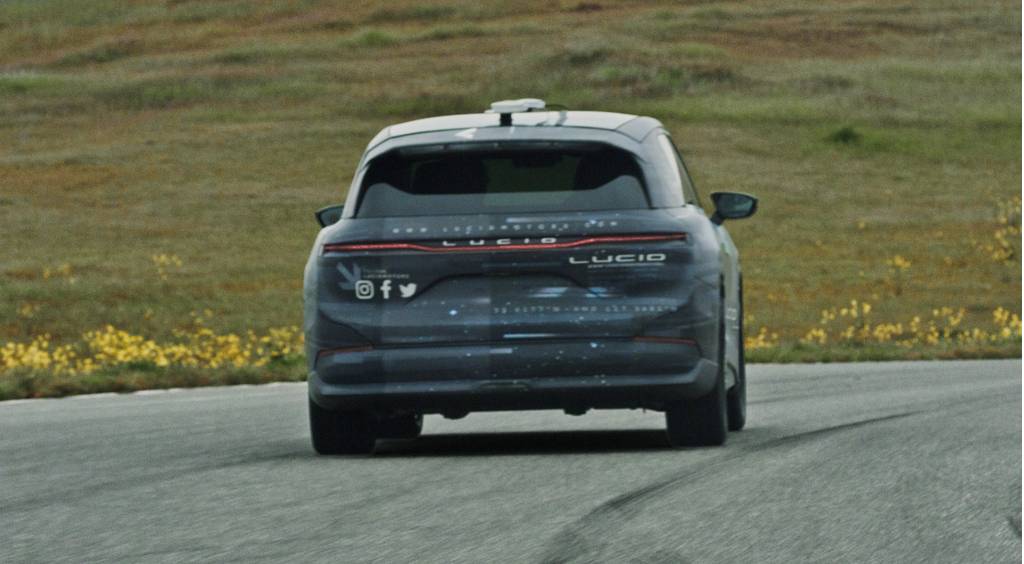Which state has used a tax on public EV charging to help cut the tax on gasoline?
Which electric automaker got a $2.5 billion lifeline this week?
This is our look back at the Week In Reverse—right here at Green Car Reports—for the week ending April 28, 2023.
General Motors confirmed that it will discontinue the Chevy Bolt EV and EUV electric cars at the end of the year, as these models’ Orion Assembly plant in Michigan transitions to electric truck production at high volume. GM hasn’t yet said what comes next, but it’s working on next-generation Ultium tech for affordable EV underpinnings with Honda.
Possible electric Chevrolet Camaro in GM Ultium teaser video
GM also announced that it will form a joint venture for battery production with Korea’s Samsung SDI. The $3 billion venture will result in one U.S. battery plant due to produce up to 30 gigawatt-hours annually of “high-performing” prismatic and cylindrical cells—different than the large-format pouch cells being made by Ultium LLC plants and perhaps the basis for an electric Corvette and Camaro.
California’s Lucid Motors revealed some first photos of its Gravity SUV undergoing testing on U.S. public roads. It’s due for a production start in 2024, with a full reveal sometime later this spring.

Lucid Gravity testing
The first mass-market, in-house-developed EV from Honda will arrive in 2025 for North America, executives confirmed Wednesday as part of a company update on restructuring its business operations around EVs and a sustainable supply chain. The EV due in two years will follow the GM-based Prologue SUV by a year and will debut a new architecture supporting over-the-air updates and Honda’s own software interface.
Volvo confirmed that its U.S.-built EX90 electric SUV is already sold out for its first-year production run—many months before production even starts. It in the meantime said that U.S. sales of its Recharge models, including plug-in hybrids and EVs, are currently over a quarter of the total.

2024 Volvo EX90 Excellence
A $2.5 billion boost for Vietnam’s Vinfast may help keep the company moving even if its IPO gets delayed—allowing the company to keep pushing along with its vision of multiple EVs for the U.S. market, including U.S. assembly in North Carolina.
A cumulative 1.5 million plug-in vehicles have been sold in California, the state reported last week. It’s hit that target about two years ahead of original aims, and it puts the state well on its path to go all-EV by 2035. California may soon require bidirectional charging capability in EVs. A bill moving through the state legislature would require regulators to ensure new EVs have the ability to discharge power from battery packs to assist the power grid or provide backup power—with technical details yet to come.

2023 Ford F-150 Lightning
The retail giant Costco draws lines of customers, and cars, with its discount gas. That in turn is a strong traffic-draw for its stores in general. But, an executive recently underscored, Costco has no plans to return to EV charging in the next few years—and even though U.S. gasoline consumption has peaked, Costco says its market share continues to grow.
EVs still cost much more than gas vehicles to insure—even considering hybrids—according to an assessment from Consumer Reports. The soaring cost of battery replacement and a higher level of writeoffs for EVs after collisions definitely has a role in that, but there is hope in at least one model costing less to insure than some comparable hybrids: the Nissan Leaf.
Batteries are outlasting expectations according to a chart provided in Tesla’s 2022 Impact Report released this week. It suggests that Model S and Model X battery packs degrade only an average 12% over 200,000 miles. Considering these models’ over-the-air efficiency updates received since new, that equates to well more than 88% of their original real-world range.

Chevrolet Bolt EV fitted with prototype airless tires from Michelin
It seems airless tires might be a step closer to reality. According to a report, Michelin says that it’s recently tested its EV-focused Uptis airless tire up to 130 mph—a speed that could qualify these tires for their use in law enforcement vehicles, as well as the autonomous vehicles.
In Utah, EV drivers will soon pay more to charge—to subsidize lower gas prices for those who guzzle from the pump. The state passed a bill last month that will impose a 12.5% tax on charging and cut the gas tax; these new economic incentives (and disincentives) go into effect July 1.

Big rigs in traffic
The Senate this week voted to block the Biden EPA’s stricter emissions rules for commercial trucks—the first tightening of big-rig tailpipe rules in 20 years. The move will halt implementation unless the President uses veto power, and it passed with the help of West Virginia Senator Joe Manchin, and Dianne Feinstein, with the latter missing the vote. It created quite the contrast with California’s Friday approval of its Advanced Clean Fleets rule, which mandates zero-emissions trucks for some use cases.
A roundup of real-world highway test results from Car and Driver helped emphasize that EPA-rated range consistently falls short on high-speed road trips. That’s because it represents a combination of driving cycles and isn’t based solely on a highway cycle.
Should EV policy be shaped around those who use the most gasoline? That’s what one advocacy group is focusing on—with the claim that switching so-called gasoline superusers to electric vehicles will make a bigger economic and environmental difference faster.

Pickup truck
And last Saturday, on Earth Day, Green Car Reports asked a litmus-test question for EV adoption: When will buying vehicles with tailpipes be seen as morally wrong? While the poll has closed, keep leaving your comments with the story, and continue the debate.
_______________________________________
Follow Green Car Reports on Facebook and Twitter
Read the full article here


